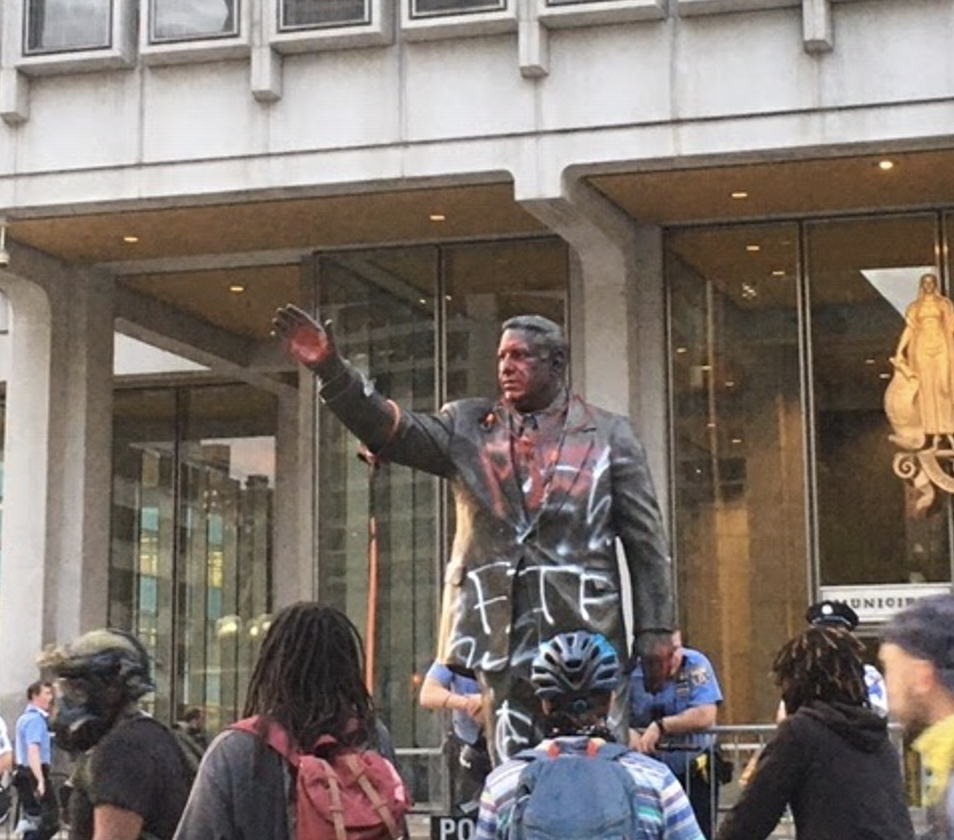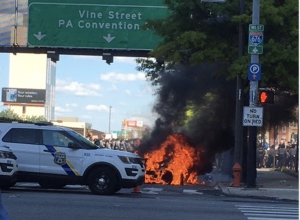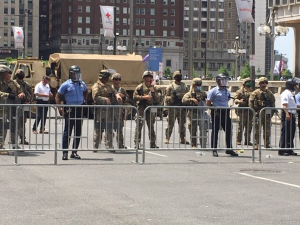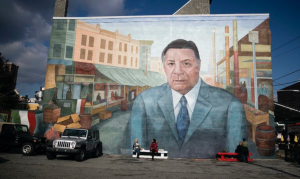from Hard Crackers

A lot can happen in a week.
On Saturday, May 30, a beautiful sunny afternoon, we joined thousands of others at the steps of the Philadelphia Art Museum to protest the murder of George Floyd by the Minneapolis police. This was the first major protest of Floyd’s death in Philadelphia, the poorest big city in the U.S., now further ravaged by the COVID-19 pandemic. After a short rally, we marched with throngs of people, chanting under our masks. We saw buildings tagged with “ACAB” and “RIP George Floyd.” There was a palpable tension in the air, a simmering rage that was not to be contained.
We were stopped near an on-ramp to the Vine Street Expressway (aka I-676, the highway that passes through Center City). The march seemed determined to get on the highway, but police had blocked the ramp. Over the heads of those in front of us, a young Black woman shouted to the crowd from atop a police SUV. Two young Black men joined her, and they raged against the police, stomping on the roof of the patrol car while everyone cheered and chanted. Soon the police SUV was on fire.
As the car went up in flames, the first of at least four to do so that day, the police pushed us out of the intersection in multiple directions. The crowd stayed loud and strong, pushing back and yelling at the cops. A shirtless guy sat atop a city bus near the intersection, casually eating a bag of chips and watching the chaos.
 A police vehicle on fire near the on-ramp of the Vine Street Expressway. (Saturday, May 30).
A police vehicle on fire near the on-ramp of the Vine Street Expressway. (Saturday, May 30).
After failing to get on the highway, we changed course toward City Hall, where things were already happening. At the Municipal Services Building, the long-reviled statue of notoriously racist former police commissioner and mayor Frank Rizzo was splashed with red paint and “FTP,” a rope tied around its extended right arm. Many tried valiantly to pull down or burn down the statue, but it remained stubbornly in its place. A formation of police officers guarded the building, occasionally pepper-spraying someone because they felt like it, but mostly ignoring what was happening with Rizzo.
Nearby, while about 10 cops guarded a TD Bank, three more police cars went up in flames in the street. Fireworks exploded into the thick smoke, and the crowd cheered. An outdoor cafe and a “pop-up” Starbucks next to City Hall were set aflame, the latter pretty much gutted by the time firefighters got near. They couldn’t get closer, as the crowd was content to let the Starbucks burn. In two decades of attending and organizing various demonstrations, we had never witnessed anything quite like this orgy of joyful rage. And the night was still young.
As the cop cars and Starbucks smoldered, police re-grouped to protect City Hall. We lingered, wondering what would happen next. We noticed excited folks appearing on the scene with boxes of new shoes. A quick walk to the shopping district of Walnut and Chestnut Streets confirmed that “an immense collection of commodities,” as Marx would say – from Apple, Modell’s, Nordstrom Rack, Vans — had been made available for redistribution. Dumpsters and furniture were repurposed as intersection barricades, as people dashed in and out of smashed storefront windows, carrying all they could. Dozens of alarm systems blared out of synch with each other. With people vastly outnumbering cops, we owned the streets and the goods. Mayor Kenney announced an 8pm curfew, but people stayed in the streets–and in the stores—regardless. Graffiti scrawled on the wall of a McDonald’s summed up the night’s joyous vibe: “I’m lovin it.”
The next morning, media predictably decried the looting. Like so many feckless leaders, Kenney and Police Commissioner Danielle Outlaw tried to lay blame on “outside agitators.” Other pieces have already ripped this age-old trope to shreds, but let us state clearly that the vast majority of folks we saw Saturday were Philadelphia’s own.
With traffic closed to much of Center City on Sunday, the protests moved to diffuse neighborhoods across the city. A comrade in West Philly described what unfolded there:
Mid-afternoon, friends and I noticed a lot of police lights flashing near 52ndand Market Street. I took a quick bike ride to check it out. A dozen or so cruisers and vans were parked in the area, and 25 to 30 cops with batons and helmets milled around looking uneasy. A crowd of about 150 was scattered around the intersection, almost exclusively Black and very young. Voices raged against the police. The mood felt tenser and angrier than the previous night’s absurd and almost joyous looting in Center City. I headed home to change and check in with housemates before returning.
By the time I got back, a few trash cans were on fire. The police had formed a tenuous line at 52nd and Chestnut. Chunks of broken pavement and shattered glass were scattered around the street and the police cruisers were dented. Occasionally someone in the crowd tossed something at the police lines. Despite having been split into two parts, one being pushed north and the other being pushed south, the crowd continued to grow. Once it became clear the cops didn’t have enough manpower to actually do anything other than hold a line, the crowd let loose and started looting. A primary goal was the Foot Locker just behind police lines.
After pulling the shutters off a few shops and tipping over some vendor booths, people got bolder and moved up on the police lines. Around this time, a SWAT vehicle with riot cops in black uniforms and gas masks showed up to reinforce the vastly outnumbered cops. A vehicle burned just north of Market Street. Without warning, a riot cop in the armored SWAT vehicle shot a few teargas rounds at the crowd while the others pushed us south on 52nd Street. People were furious and responded by lighting up a building. Inexplicably, the SWAT vehicle left the scene after this. After checking social media, it was clear why: This was happening all over the city! The cops didn’t have enough armor to hold any one place and had to send the SWAT vehicles careening all over the city to reinforce their positions.
Eventually, people forced the police to retreat. They abandoned one of their cruisers blocking the back door to the Foot Locker, which was smashed and entered almost immediately. The SWAT vehicle returned to fire teargas rounds into the crowd of black teenagers looting the Foot Locker. At this point, firefighters had arrived to put out a building fire a few blocks south. It was surreal to see a crowd completely ignore the firefighters, letting them go about their business. The crowd was hyped, but I saw no interpersonal violence. No fighting, just looting or throwing stuff at the cops. Civilian cars moved through the scene without getting so much as a scratch.
The cops were pissed about getting their asses handed to them the night before and were out for revenge. The SWAT vehicle stuck around longer, firing teargas and rubber bullets into the crowd. Their only specific targets seemed to be street medics. One had her helmet shot off her head by a rubber bullet. She was also hit in the arm. They hit a young white woman in the face. With blood pouring from the wound and covering her jeans, people helped her back to the firefighters, who got her to an ambulance. The cops launched another barrage of teargas rounds at us, even though we had been retreating. Multiple teargas canisters landed directly among the firefighters, spinning crazily and spewing gas around the fire trucks. Some firefighters had to abandon the smoldering building to wash out their eyes.
The crowd started dispersing, mostly to loot the box stores on City Line Ave, but the SWAT vehicle stuck around to punish the neighborhood for the uprising. It drove up and down 52nd Street, launching teargas canister after teargas canister down residential side streets. It didn’t matter if anyone was in the street or not, they just gassed people in their homes.
Something noteworthy was the mood and concentration of the rioting and looting. It was extremely focused on 52nd Street from Arch to the north and about Spruce to the south. Drugstores were cleaned out, as were a few dollar stores and vendors’ booths. And of course the Foot Locker. But most businesses were untouched, even ones with large glass windows. Many had painted “Black-owned” across the windows. The library on 52nd Street was not damaged, and the residential neighborhoods were untouched by the crowd, as were civilian cars. Early on, one person threw a rock at a SEPTA bus, but was quickly denounced by the crowd.
On Monday, National Guard troops showed up. The uprisings continued and people again filled the streets. In the early evening, a crowd of thousands halted traffic on the previously impenetrable Vine Street Expressway. In response, police let loose with a torrent of teargas and pepper spray, targeting people fleeing toward the only way out, over a steep embankment.
Meanwhile, just north of Center City, in the gentrified neighborhood of Fishtown, white vigilantes roamed the streets with baseball bats, golf clubs, and hammers, claiming to be a defense against activists and looters– none of whom had made their way to Fishtown’s streets. Many folks oriented toward justice and liberation– those the vigilantes feared– had already been teargassed on the highway. But their brandishing of weapons, along with a few actual assaults on people, including reporters, certainly scared some people. Philly cops eventually showed up, apparently only to take photos and yuk it up with these so-called protectors, who also, it must be noted, were out in the streets well after the city-imposed curfew.
On Wednesday, in the wee hours of the morning, the defaced and heavily guarded Rizzo statue was hauled away by city workers. What more than a decade of pressure by mostly respectable Black Philadelphians couldn’t accomplish, a days-long uprising by entirely ungovernable, mostly Black, mostly young people did. Mayor Kenney had hemmed and hawed for the past two years about taking down the Rizzo statue. He even tweeted on Saturday, May 30th, that “he never liked it” and that it was slated to be removed next month. But those who were in the streets as May gave way to June know the real truth: they were the ones who banished Rizzo for good.
Saturday, June 6 was another beautiful day, though warmer. The gathering again began at the Art Museum steps. The crowd was more than double the size of the previous week’s estimated 4,000. Although they weren’t visible at the museum, National Guard troops were just around the corner, lining the perimeter of city blocks the mayor had closed to traffic in anticipation of the protests. There was a line of porta potties that weren’t there the week before. The rally became a march, and people swelled into the empty streets. The crowd was huge and still chanting but felt less urgent and angry than a week earlier. With all of center city closed to traffic, there was lots of room to roam: city leaders had conceded lots of space to “peaceful protest.”
 The same area one week later (Municipal Services Building where Rizzo had stood is to the right of photo.)
The same area one week later (Municipal Services Building where Rizzo had stood is to the right of photo.)
The exception to the open streets was the area between City Hall and the municipal building where the Rizzo statue had recently stood. Dark spots marked the outlines of charred police cars that had been hauled away. Lines of police, National Guard troops, and military trucks barricaded this small swath of the city. The TD Bank across the street was unguarded, after being protected like one’s firstborn the week before. Throughout the day and into the evening, protesters occasionally yelled at the cops and Guard troopers, but the tone was much less confrontational than the previous week, and included calls for the enemy to “kneel with us.”
A simplistic contrasting of the two large Saturday protests might say one was more “Fuck 12” and “ACAB,” and the other more “End Qualified Immunity” and “I’m not Black, but I see you.” Maybe this signals the beginning of the funnelling of insurgent politics into so-called respectable avenues. Or perhaps these contrasts do not tell the whole story. For one, after protesters had been teargassed for several days and the uber-armed National Guard had been present for six days, there still were twice the number of people out the second Saturday. In a city that had been under curfew for a week, people came out to protest not only the murdering of black people by police, but also the heavy hand of the city and state police. At a time when the mayor has called for the firing of hundreds of city employees amidst the pandemic, city activists and perhaps the newly energized are primed to fight these cuts and instead raise the practical solution of defunding the police.
In the early morning hours of Sunday, June 7, Mural Arts Philadelphia painted over the large mural of Frank Rizzo at the Italian Market in South Philadelphia. Mural Arts, which was commissioned to paint the mural, worked with the owners of the building to remove it and will work with them to “collaborat(e) with the community on a new mural project that can reflect the fabric of South 9th Street.” Also on Sunday, notably, the citywide curfew was lifted for the first time in a week.
 After a crew painted over the mural of former top cop and mayor Frank Rizzo early Sunday morning, all that remained was the street sign on the upper right hand side.
After a crew painted over the mural of former top cop and mayor Frank Rizzo early Sunday morning, all that remained was the street sign on the upper right hand side.
When we say a lot can happen in a week, we mean to say that riots fucking work. The bridges are open. The streets are clear. Although center city is still boarded up, much of the graffiti is painted over. The glass on the sidewalks outside the fancy stores is cleaned up. In just one week, the mayor, in a pathetic hope at flashing some progressive credentials, has conveniently scrubbed away the awful legacy of the Rizzo years and, bowing to the pressure of once-in-a-generation riots, has completely reversed his initial proposal for a $19 million budget increase for the cops. But the rallies and marches continue, and the Fishtown vigilantes and those who light a candle to Daniel Faulkner’s memory in South Philadelphia haven’t gone anywhere, either. The fissures that follow the long line of white supremacist policing both in Philadelphia and beyond have been split open as wide as ever.